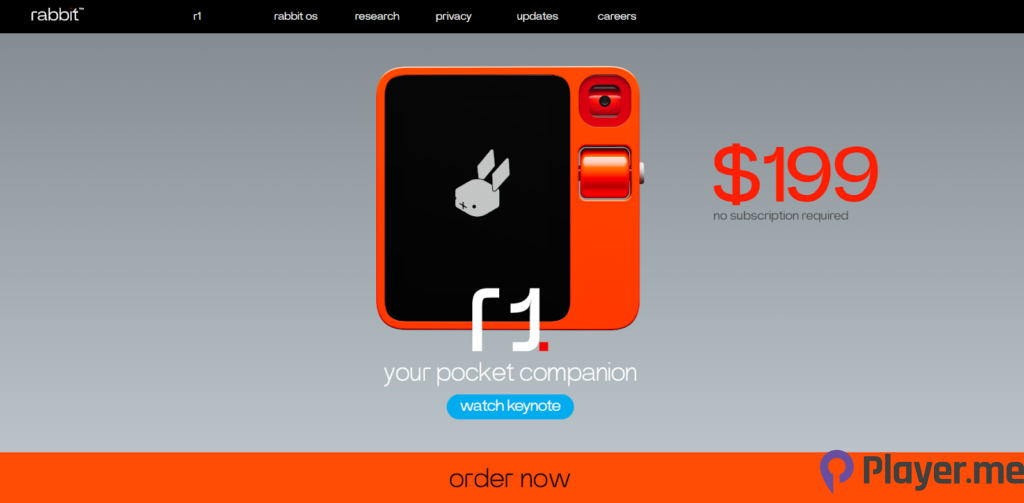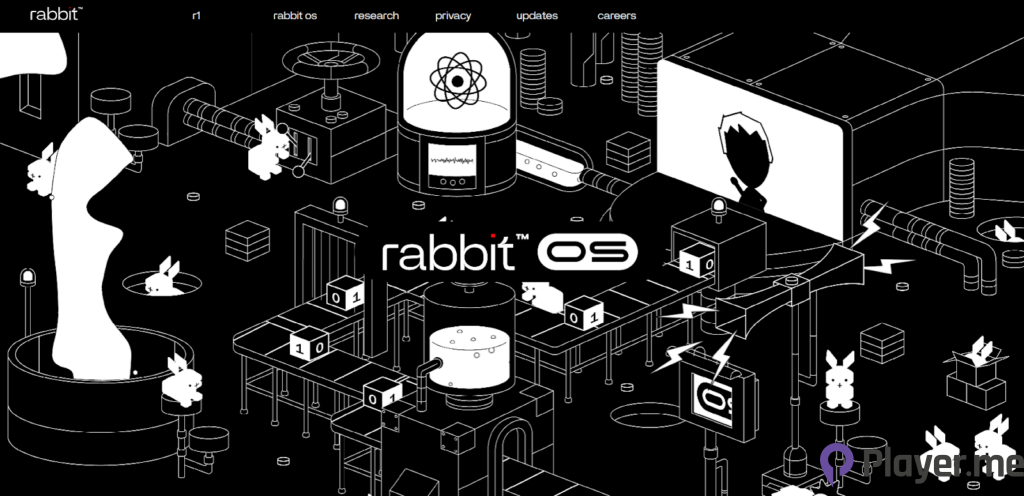In the bustling world of technological advancements, the Rabbit R1 emerges as a modest yet intriguing addition, promising to redefine our interaction with artificial intelligence. This standalone AI-powered device, priced at $199, positions itself not as a smartphone replacement but as a pocketable assistant aimed at simplifying our daily tasks.
A Closer Look at Rabbit R1’s Hardware
Designed in collaboration with Teenage Engineering, the Rabbit R1 sports a playful, retro-inspired aesthetic. Its compact size, reminiscent of a Tamagotchi, conceals a 2.88-inch touchscreen, a rotating camera, and a scroll wheel for navigation. While the device may seem unassuming, its tactile buttons and responsive controls create a surprisingly pleasant user experience.

Under the hood, the R1 is equipped with a 2.3GHz MediaTek processor, 4GB of RAM, and 128GB of storage. The device boasts cellular connectivity through a SIM card slot, enabling it to operate independently. The 360-degree rotating camera, named the Rabbit Eye, adds a unique touch, facilitating visual queries and providing a practical use for its camera functionality.
The Unique Software: Rabbit OS and Large Action Model (LAM)
At the heart of the Rabbit R1’s capabilities lies the Rabbit OS, powered by a Large Action Model (LAM). This innovative approach distinguishes it from conventional AI models. Unlike traditional large language models, the LAM is trained not on words but on actions, mirroring how humans interact with apps.
Rabbit OS acts as a universal controller for apps, aiming to streamline tasks without the need for app-specific integrations.

The LAM, having learned from human interactions with apps like Spotify and Uber, can understand complex user intentions, operate interfaces, and execute actions on behalf of the user. This training process involves humans interacting with apps to showcase how they work, enabling the LAM to replicate these actions across various platforms and desktop environments.
In essence, Rabbit OS serves as a comprehensive solution, offering voice-activated control over a multitude of services, from music playback to ordering groceries. The device’s on-screen interface presents category-based cards, ensuring users can verify the LAM’s output.
Real-world Applications
The Rabbit R1’s practical applications extend beyond basic voice commands. The device can undertake complex, multistep tasks, such as creating itineraries or removing watermarks from photos. A dedicated training mode allows users to teach the device-specific actions, empowering it to perform those tasks independently in the future.
For instance, the R1 can learn to interact with software like Photoshop. Users guide the device through tasks, and Rabbit OS processes the information, enabling the R1 to autonomously replicate these actions. This practicality positions the Rabbit R1 not as a mere voice assistant but as a device capable of intricate and nuanced tasks.
Navigating the Rabbit Hole
Rabbit R1’s approach to app interaction sidesteps the need for developers to support the device by training the LAM on how to use existing apps. The device seamlessly connects to various services through a web portal known as the “Rabbit Hole”. This portal allows users to log in to their preferred services and grant the R1 access, ensuring a tailored and personalised experience.
By connecting to existing services, Rabbit R1 promises privacy and security. While the device requires users to log in to their services through its interface, it claims not to store login data or create proxy accounts. This approach aims to enhance the safety and efficiency of the user experience.
Consumer Insights and Expectations
The Rabbit R1 isn’t positioned as a smartphone replacement but as a companion device designed to save time and streamline tasks. Recognising the allure of smartphones for leisure, the R1 focuses on efficiency, aiming to be the go-to gadget for handling daily responsibilities.
While it acknowledges the potential to become a handset substitute, it remains grounded in its goal of providing a breakthrough product for users seeking a balance between functionality and simplicity.
Comparisons with Competitors
In a market flooded with virtual assistants, Rabbit R1 distinguishes itself by its unique LAM approach and focus on comprehensive, complex task handling. It challenges the traditional smartphone-centric model by offering a standalone device that connects to existing services without relying on a multitude of app integrations.
Priced at $199, Rabbit R1 competes favourably in terms of affordability compared to competitors like Humane’s AI Pin and Ray-Ban Meta smart glasses. The device’s potential to perform intricate actions, combined with its accessible price point, positions it as an attractive option for those seeking a cost-effective entry into AI-driven hardware.
Rabbit R1’s Future Vision
While Rabbit R1’s future vision remains somewhat unclear, it presents itself as an innovative solution for users seeking a practical and efficient AI companion. The device’s design, hardware capabilities, and unique software approach create a promising entry point into the world of AI-driven gadgets.
As Rabbit R1 becomes available for pre-order, the industry awaits the device’s real-world performance. If you are just as excited towards the possibilities of this pocketable AI companion, be sure to stay tuned in Player.me for the latest news.
Author Profile
Latest entries
 GAMING2024.06.12Top 4 Female Tekken 8 Fighters to Obliterate Your Opponents in Style!
GAMING2024.06.12Top 4 Female Tekken 8 Fighters to Obliterate Your Opponents in Style! NEWS2024.03.18Elon Musk’s SpaceX Ventures into National Security to Empower Spy Satellite Network for U.S.
NEWS2024.03.18Elon Musk’s SpaceX Ventures into National Security to Empower Spy Satellite Network for U.S. GAMING2024.03.17PS Plus: 7 New Games for March and Beyond
GAMING2024.03.17PS Plus: 7 New Games for March and Beyond GAMING2024.03.17Last Epoch Necromancer Builds: All You Need To Know About It
GAMING2024.03.17Last Epoch Necromancer Builds: All You Need To Know About It





